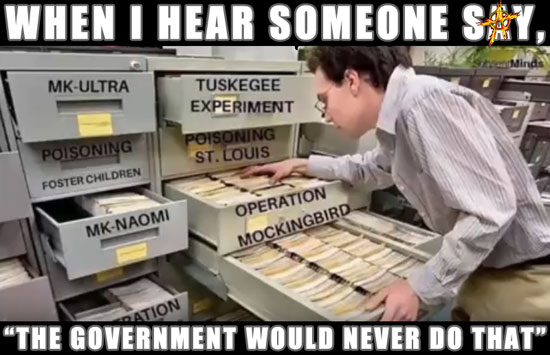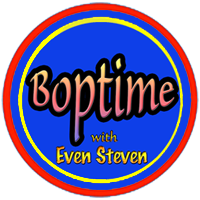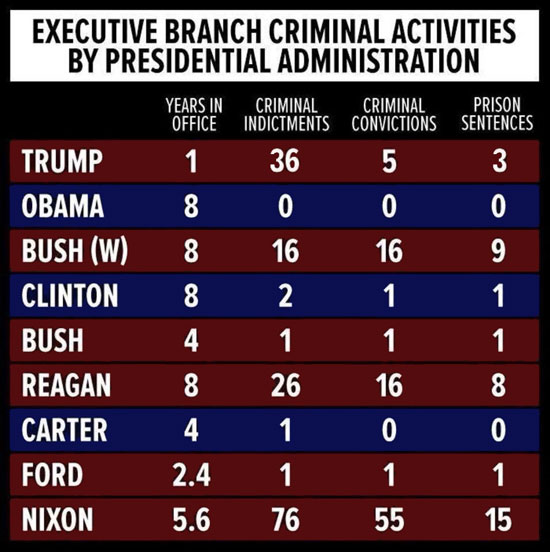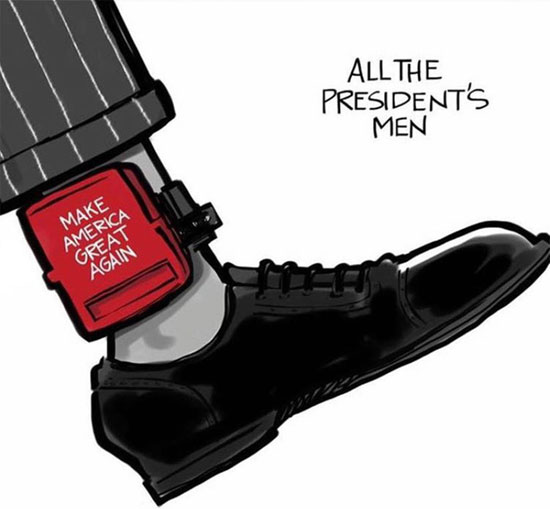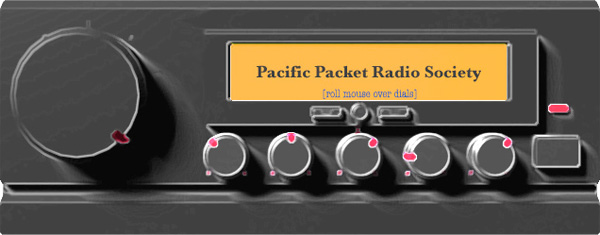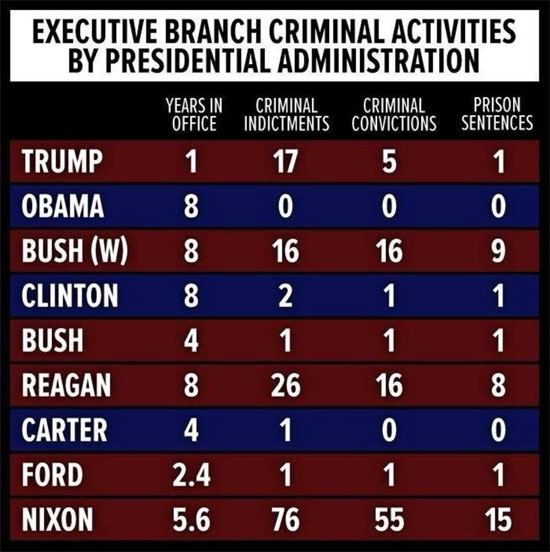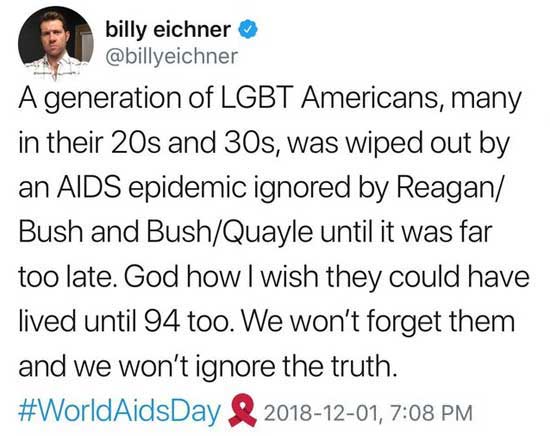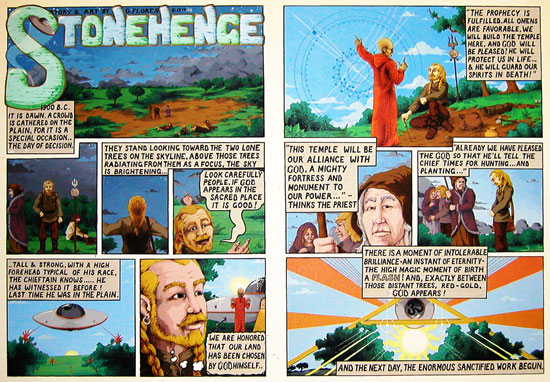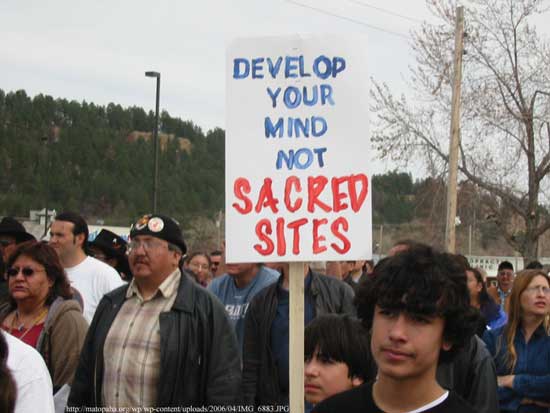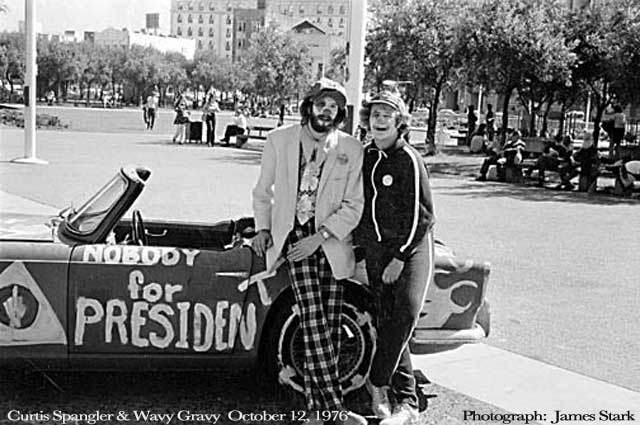NONE of the ABOVE should be a valid choice on Voter Ballots!
During times of universal deceit, telling the truth becomes a revolutionary act. ~ George OrwellWhere Have All the Flowers Gone?
Reflections on the Spirit & Legacy of the Sixties by Fritjof Capra, 200212.01
The 1960s were the period of my life during which I experienced the most profound and most radical personal transformation. For those of us who identify with the cultural and political movements of the sixties, that period represents not so much a decade as a state of consciousness, characterized by "transpersonal" expansion, the questioning of authority, a sense of empowerment, and the experience of sensuous beauty and community.
This state of consciousness reached well into the seventies. In fact, one could say that the sixties came to an end only in December 1980, with the shot that killed John Lennon. The immense sense of loss felt by so many of us was, to a great extent, about the loss of an era. For a few days after the fatal shooting we relived the magic of the sixties. We did so in sadness and with tears, but the same feeling of enchantment and of community was once again alive. Wherever you went during those few days - in every neighborhood, every city, every country around the world - you heard John Lennon's music, and the intense idealism that had carried us through the sixties manifested itself once again:
You may say I'm a dreamer, but I'm not the only one. I hope some day you'll join us and the world will live as one. In this essay, I shall try to evoke the spirit of that remarkable period, identify its defining characteristics, and provide an answer to some questions that are often asked nowadays: What happened to the cultural movements of the sixties? What did they achieve, and what, if any, is their legacy?
expansion of consciousness
The era of the sixties was dominated by an expansion of consciousness in two directions. One movement, in reaction to the increasing materialism and secularism of Western society, embraced a new kind of spirituality akin to the mystical traditions of the East. This involved an expansion of consciousness toward experiences involving nonordinary modes of awareness, which are traditionally achieved through meditation but may also occur in various other contexts, and which psychologists at the time began to call "transpersonal." Psychedelic drugs played a significant role in that movement, as did the human potential movement's promotion of expanded sensory awareness, expressed in its exhortation, "Get out of your head and into your senses!"
The first expansion of consciousness, then, was a movement beyond materialism and toward a new spirituality, beyond ordinary reality via meditative and psychedelic experiences, and beyond rationality through expanded sensory awareness. The combined effect was a continual sense of magic, awe, and wonder that for many of us will forever be associated with the sixties.
questioning of authority
The other movement was an expansion of social consciousness, triggered by a radical questioning of authority. This happened independently in several areas. While the American civil rights movement demanded that Black citizens be included in the political process, the free speech movement at Berkeley and student movements at other universities throughout the United States and Europe demanded the same for students.
In Europe, these movements culminated in the memorable revolt of French university students that is still known simply as "May '68." During that time, all research and teaching activities came to a complete halt at most French universities when the students, led by Daniel Cohn-Bendit, extended their critique to society as a whole and sought the solidarity of the French labor movement to change the entire social order. For three weeks, the administrations of Paris and other French cities, public transport, and businesses of every kind were paralyzed by a general strike. In Paris, people spent most of their time discussing politics in the streets, while the students held strategic discussions at the Sorbonne and other universities. In addition, they occupied the Odéon, the spacious theater of the Comédie Française, and transformed it into a twenty-four-hour "people's parliament," where they discussed their stimulating, albeit highly idealistic, visions of a future social order.
1968 was also the year of the celebrated "Prague Spring," during which Czech citizens, led by Alexander Dubcek, questioned the authority of the Soviet regime, which alarmed the Soviet Communist party to such an extent that, a few months later, it crushed the democratization processes initiated in Prague in its brutal invasion of Czechoslovakia.
In the United States, opposition to the Vietnam war became a political rallying point for the student movement and the counterculture. It sparked a huge anti-war movement, which exerted a major influence on the American political scene and led to many memorable events, including the decision by President Johnson not to seek reelection, the turbulent 1968 Democratic Convention in Chicago, the Watergate scandal, and the resignation of President Nixon.
a new sense of community
While the civil rights movement questioned the authority of white society and the student movements questioned the authority of their universities on political issues, the women's movement began to question patriarchal authority; humanistic psychologists undermined the authority of doctors and therapists; and the sexual revolution, triggered by the availability of birth control pills, broke down the puritan attitudes toward sexuality that were typical of American culture.
The radical questioning of authority and the expansion of social and transpersonal consciousness gave rise to a whole new culture - a "counterculture" - that defined itself in opposition to the dominant "straight" culture by embracing a different set of values. The members of this alternative culture, who were called "hippies" by outsiders but rarely used that term themselves, were held together by a strong sense of community. To distinguish ourselves from the crew cuts and polyester suits of that era's business executives, we wore long hair, colorful and individualistic clothes, flowers, beads, and other jewelry. Many of us were vegetarians who often baked our own bread, practiced yoga or some other form of meditation, and learned to work with our hands in various crafts.
Our subculture was immediately identifiable and tightly bound together. It had its own rituals, music, poetry, and literature; a common fascination with spirituality and the occult; and the shared vision of a peaceful and beautiful society. Rock music and psychedelic drugs were powerful bonds that strongly influenced the art and lifestyle of the hippie culture. In addition, the closeness, peacefulness, and trust of the hippie communities were expressed in casual communal nudity and freely shared sexuality. In our homes we would frequently burn incense and keep little altars with eclectic collections of statues of Indian gods and goddesses, meditating Buddhas, yarrow stalks or coins for consulting the I Ching, and various personal "sacred" objects.
Although different branches of the sixties movement arose independently and often remained distinct movements with little overlap for several years, they eventually became aware of one another, expressed mutual solidarity, and, during the 1970s, merged more or less into a single subculture. By that time, psychedelic drugs, rock music, and the hippie fashion had transcended national boundaries and had forged strong ties among the international counterculture. Multinational hippie tribes gathered in several countercultural centers - London, Amsterdam, San Francisco, Greenwich Village - as well as in more remote and exotic cities like Marrakech and Katmandu. These frequent cross-cultural exchanges gave rise to an "alternative global awareness" long before the onset of economic globalization.
the sixties' music
The zeitgeist of the sixties found expression in many art forms that often involved radical innovations, absorbed various facets of the counterculture, and strengthened the multiple relationships among the international alternative community.
Rock music was the strongest among these artistic bonds. The Beatles broke down the authority of studios and songwriters by writing their own music and lyrics, creating new musical genres, and setting up their own production company. While doing so, they incorporated many facets of the period's characteristic expansion of consciousness into their songs and lifestyles.
Bob Dylan expressed the spirit of the political protests in powerful poetry and music that became anthems of the sixties. The Rolling Stones represented the counterculture's irreverence, exuberance, and sexual energy, while San Francisco's "acid rock" scene gave expression to its psychedelic experiences.
At the same time, the "free jazz" of John Coltrane, Ornette Coleman, Sun Ra, Archie Shepp, and others shattered conventional forms of jazz improvisation and gave expression to spirituality, radical political poetry, street theater, and other elements of the counterculture. Like the jazz musicians, classical composers, such as Karlheinz Stockhausen in Germany and John Cage in the United States, broke down conventional musical forms and incorporated much of the sixties' spontaneity and expanded awareness into their music.
The fascination of the hippies with Indian religious philosophies, art, and culture led to a great popularity of Indian music. Most record collections in those days contained albums of Ravi Shankar, Ali Akbar Khan, and other masters of classical Indian music along with rock and folk music, jazz and blues.
The rock and drug culture of the sixties found its visual expressions in the psychedelic posters of the era's legendary rock concerts, especially in San Francisco, and in album covers of ever increasing sophistication, which became lasting icons of the sixties' subculture. Many rock concerts also featured "light shows" - a novel form of psychedelic art in which images of multicolored, pulsating, and ever changing shapes were projected onto walls and ceilings. Together with the loud rock music, these visual images created highly effective simulations of psychedelic experiences.
new literary forms
The main expressions of sixties' poetry were in the lyrics of rock and folk music. In addition, the "beat poetry" of Allen Ginsberg, Lawrence Ferlinghetti, Gary Snyder, and others, which had originated a decade earlier and shared many characteristics with the sixties' art forms, remained popular in the counterculture.
One of the major new literary forms was the "magical realism" of Latin American literature. In their short stories and novels, writers like Jorges Luis Borges and Gabriel García Márquez blended descriptions of realistic scenes with fantastic and dreamlike elements, metaphysical allegories, and mythical images. This was a perfect genre for the counterculture's fascination with altered states of consciousness and pervasive sense of magic.
In addition to the Latin American magical realism, science fiction, especially the complex series of Dune novels by Frank Herbert, exerted great fascination on the sixties' youth, as did the fantasy writings of J. R. R. Tolkien and Kurt Vonnegut. Many of us also turned to literary works of the past, such as the romantic novels of Hermann Hesse, in which we saw reflections of our own experiences.
Of equal, if not greater, popularity were the semi-fictional shamanistic writings of Carlos Castaneda, which satisfied the hippies' yearning for spirituality and "separate realities" mediated by psychedelic drugs. In addition, the dramatic encounters between Carlos and the Yaqui sorcerer Don Juan symbolized in a powerful way the clashes between the rational approach of modern industrial societies and the wisdom of traditional cultures.
film and the performing arts
In the sixties, the performing arts experienced radical innovations that broke every imaginable tradition of theater and dance. In fact, in companies like the Living Theater, the Judson Dance Theater, and the San Francisco Mime Troupe, theater and dance were often fused and combined with other forms of art. The performances involved trained actors and dancers as well as visual artists, musicians, poets, filmmakers, and even members of the audience.
Men and women often enjoyed equal status; nudity was frequent. Performances, often with strong political content, took place not only in theaters but also in museums, churches, parks, and in the streets. All these elements combined to create the dramatic expansion of experience and strong sense of community that was typical of the counterculture.
Film, too, was an important medium for expressing the zeitgeist of the sixties. Like the performing artists, the sixties' filmmakers, beginning with the pioneers of the French New Wave cinema, broke with the traditional techniques of their art, introducing multi-media approaches, often abandoning narratives altogether, and using their films to give a powerful voice to social critique.
With their innovative styles, these filmmakers expressed many key characteristics of the counterculture. For example, we can find the sixties' irreverence and political protest in the films of Godard; the questioning of materialism and a pervasive sense of alienation in Antonioni; questioning of the social order and transcendence of ordinary reality in Fellini; the exposure of class hypocrisy in Buñuel; social critique and utopian visions in Kubrik; the breaking down of sexual and gender stereotypes in Warhol; and the portrayal of altered states of consciousness in the works of experimental filmmakers like Kenneth Anger and John Whitney. In addition, the films of these directors are characterized by a strong sense of magical realism.
the legacy of the sixties
Many of the cultural expressions that were radical and subversive in the sixties have been accepted by broad segments of mainstream culture during the subsequent three decades. Examples would be the long hair and sixties fashion, the practice of Eastern forms of meditation and spirituality, recreational use of marijuana, increased sexual freedom, rejection of sexual and gender stereotypes, and the use of rock (and more recently rap) music to express alternative cultural values. All of these were once expressions of the counterculture that were ridiculed, suppressed, and even persecuted by the dominant mainstream society.
Beyond these contemporary expressions of values and esthetics that were shared by the sixties' counterculture, the most important and enduring legacy of that era has been the creation and subsequent flourishing of a global alternative culture that shares a set of core values. Although many of these values - e.g. environmentalism, feminism, gay rights, global justice - were shaped by cultural movements in the seventies, eighties, and nineties, their essential core was first expressed by the sixties' counterculture. In addition, many of today's senior progressive political activists, writers, and community leaders trace the roots of their original inspiration back to the sixties.
Green politics
In the sixties we questioned the dominant society and lived according to different values, but we did not formulate our critique in a coherent, systematic way. We did have concrete criticisms on single issues, such as the Vietnam war, but we did not develop any comprehensive alternative system of values and ideas. Our critique was based on intuitive feeling; we lived and embodied our protest rather than verbalizing and systematizing it.
The seventies brought consolidation of our views. As the magic of the sixties gradually faded, the initial excitement gave way to a period of focusing, digesting, and integrating. Two new cultural movements, the ecology movement and the feminist movement, emerged during the seventies and together provided the much-needed broad framework for our critique and alternative ideas.
The European student movement, which was largely Marxist oriented, was not able to turn its idealistic visions into realities during the sixties. But it kept its social concerns alive during the subsequent decade, while many of its members went through profound personal transformations. Influenced by the two major political themes of the seventies, feminism and ecology, these members of the "new left" broadened their horizons without losing their social consciousness. At the end of the decade, many of them became the leaders of transformed socialist parties. In Germany, these "young socialists" formed coalitions with ecologists, feminists, and peace activists, out of which emerged the Green Party - a new political party whose members confidently declared: "We are neither left nor right; we are in front."
During the 1980s and 1990s, the Green movement became a permanent feature of the European political landscape, and Greens now hold seats in numerous national and regional parliaments around the world. They are the political embodiment of the core values of the sixties.
the end of the Cold War
During the 1970s and 1980s, the American anti-war movement expanded into the anti-nuclear and peace movements, in solidarity with corresponding movements in Europe, especially those in the UK and West Germany. This, in turn, sparked a powerful peace movement in East Germany, led by the Protestant churches, which maintained regular contacts with the West German peace movement, and in particular with Petra Kelly, the charismatic leader of the German Greens.
When Mikhail Gorbachev came to power in the Soviet Union in 1985, he was well aware of the strength of the Western peace movement and accepted our argument that a nuclear war cannot be won and should never be fought. This realization played an important part in Gorbachev's "new thinking" and his restructuring (perestroika) of the Soviet regime, which would lead, eventually, to the fall of the Berlin Wall, the Velvet Revolution in Czechoslovakia, and the end of Soviet Communism.
All social and political systems are highly nonlinear and do not lend themselves to being analyzed in terms of linear chains of cause and effect. Nevertheless, careful study of our recent history shows that the key ingredient in creating the climate that led to the end of the Cold War was not the hard-line strategy of the Reagan administration, as the conservative mythology would have it, but the international peace movement. This movement clearly had its political and cultural roots in the student movements and counterculture of the sixties.
the information technology revolution
The last decade of the twentieth century brought a global phenomenon that took most cultural observers by surprise. A new world emerged, shaped by new technologies, new social structures, a new economy, and a new culture. "Globalization" became the term used to summarize the extraordinary changes and the seemingly irresistible momentum that were now felt by millions of people.
A common characteristic of the multiple aspects of globalization is a global information and communications network based on revolutionary new technologies. The information technology revolution is the result of a complex dynamic of technological and human interactions, which produced synergistic effects in three major areas of electronics - computers, microelectronics, and telecommunications. The key innovations that created the radically new electronic environment of the 1990s all took place 20 years earlier, during the 1970s.
It may be surprising to many that, like so many other recent cultural movements, the information technology revolution has important roots in the sixties' counterculture. It was triggered by a dramatic technological development - a shift from data storage and processing in large, isolated machines to the interactive use of microcomputers and the sharing of computer power in electronic networks. This shift was spearheaded by young technology enthusiasts who embraced many aspects of the counterculture, which was still very much alive at that time.
The first commercially successful microcomputer was built in 1976 by two college dropouts, Steve Wosniak and Steve Jobs, in their now legendary garage in Silicon Valley. These young innovators and others like them brought the irreverent attitudes, freewheeling lifestyles, and strong sense of community they had adopted in the counterculture to their working environments. In doing so, they created the relatively informal, open, decentralized, and cooperative working styles that became characteristic of the new information technologies.
global capitalism
However, the ideals of the young technology pioneers of the seventies were not reflected in the new global economy that emerged from the information technology revolution 20 years later. On the contrary, what emerged was a new materialism, excessive corporate greed, and a dramatic rise of unethical behavior among our corporate and political leaders. These harmful and destructive attitudes are direct consequences of a new form of global capitalism, structured largely around electronic networks of financial and informational flows. The so-called "global market" is a network of machines programmed according to the fundamental principle that money-making should take precedence over human rights, democracy, environmental protection, or any other value.
Since the new economy is organized according to this quintessential capitalist principle, it is not surprising that it has produced a multitude of interconnected harmful consequences that are in sharp contradiction to the ideals of the global Green movement: rising social inequality and social exclusion, a breakdown of democracy, more rapid and extensive deterioration of the natural environment, and increasing poverty and alienation. The new global capitalism has threatened and destroyed local communities around the world; and with the pursuit of an ill-conceived biotechnology, it has invaded the sanctity of life by attempting to turn diversity into monoculture, ecology into engineering, and life itself into a commodity.
It has become increasingly clear that global capitalism in its present form is unsustainable and needs to be fundamentally redesigned. Indeed, scholars, community leaders, and grassroots activists around the world are now raising their voices, demanding that we must "change the game" and suggesting concrete ways of doing so.
the global civil society
At the turn of this century, an impressive global coalition of nongovernmental organizations (NGOs), many of them led by men and women with deep personal roots in the sixties, formed around the core values of human dignity and ecological sustainability. In 1999, hundreds of these grassroots organizations interlinked electronically for several months to prepare for joint protest actions at the meeting of the World Trade Organization (WTO) in Seattle. The "Seattle Coalition," as it is now called, was extremely successful in derailing the WTO meeting and in making its views known to the world. Its concerted actions have permanently changed the political climate around the issue of economic globalization.
Since that time, the Seattle Coalition, or "global justice movement," has not only organized further protests but has also held several World Social Forum meetings in Porto Alegre, Brazil. At the second of these meetings, the NGOs proposed a whole set of alternative trade policies, including concrete and radical proposals for restructuring global financial institutions, which would profoundly change the nature of globalization.
The global justice movement exemplifies a new kind of political movement that is typical of our Information Age. Because of their skillful use of the Internet, the NGOs in the coalition are able to network with each other, share information, and mobilize their members with unprecedented speed. As a result, the new global NGOs have emerged as effective political actors who are independent of traditional national or international institutions. They constitute a new kind of global civil society.
This new form of alternative global community, sharing core values and making extensive use of electronic networks in addition to frequent human contacts, is one of the most important legacies of the sixties. If it succeeds in reshaping economic globalization so as to make it compatible with the values of human dignity and ecological sustainability, the dreams of the "sixties revolution" will have been realized:
Imagine no possessions, I wonder if you can, no need for greed or hunger, a brotherhood of man. Imagine all the people sharing all the world...You may say I'm a dreamer, but I'm not the only one.I hope some day you'll join us and the world will live as one.
If we can raise 15M for a wall there
should be no homeless veterans ?
Hipster Party ~ It’s Your Town Short Film Series via Fora Productions
Will Politicians Be Held Responsible For The Rape & Pillage Of Democracy?
MKUltra, Tuskegee, Foster Children, Saint Louis, MKNAOMI, MockingbirdBone Spur Chickenhawk Coward
Boptime w/Even Steven Leech
Saturday's Boptime begins at 6am ((EST)) with an hour of oldies back to back to back, followed at 7am ((EST)) by Rockabilly Ridge with Michael Ace. At 8am ((EST)), and for the remainder of the program, we’ll spend on this day in 1967, at the end of a psychedelic year of peace and love, and when the music was moving into new realms and new social and cultural intent. ~ Steve
BOPTIME: Saturday, 6 AM Eastern time, 3 AM Pacific time
Go To: http://www.wvud.org/?page_id=24
Click on a listening link below the WVUD logo:
Boptime available locally on WVUD-FM 91.3,
Shoutcast [Search: WVUD], and TuneIn
By the Rivers Of Babylon, Psalm 137 via Joel Aguiar de Menezes
Imelda May, It's Good To Be Alive via prano bailey-bond
Brooks & Dunn, Hillbilly Deluxe via HQ Creative

Dahbud Mensch ~ Stuck in the middle with WHO ? ::: Why The FDA Cannot Be Trusted
Risky Drugs:
Why The FDA Cannot Be TrustedHarvard University, Edmond J. Safra Center for Ethics
July 17, 2013 by Donald W. Light, Article Source
A forthcoming article for the special issue of the Journal of Law, Medicine and Ethics (JLME), edited by Marc Rodwin and supported by the Edmond J. Safra Center for Ethics, presents evidence that about 90 percent of all new drugs approved by the FDA over the past 30 years are little or no more effective for patients than existing drugs.
All of them may be better than indirect measures or placebos, but most are no better for patients than previous drugs approved as better against these measures. The few superior drugs make important contributions to the growing medicine chest of effective drugs.
The bar for “safe” is equally low, and over the past 30 years, approved drugs have caused an epidemic of harmful side effects, even when properly prescribed. Every week, about 53,000 excess hospitalizations and about 2400 excess deaths occur in the United States among people taking properly prescribed drugs to be healthier. One in every five drugs approved ends up causing serious harm,[1] while one in ten provide substantial benefit compared to existing, established drugs. This is the opposite of what people want or expect from the FDA.
Prescription drugs are the 4th leading cause of death. Deaths and hospitalizations from over-dosing, errors, or recreational drug use would increase this total. American patients also suffer from about 80 million mild side effects a year, such as aches and pains, digestive discomforts, sleepiness or mild dizziness.
The forthcoming article in JLME also presents systematic, quantitative evidence that since the industry started making large contributions to the FDA for reviewing its drugs, as it makes large contributions to Congressmen who have promoted this substitution for publicly funded regulation, the FDA has sped up the review process with the result that drugs approved are significantly more likely to cause serious harm, hospitalizations, and deaths. New FDA policies are likely to increase the epidemic of harms. This will increase costs for insurers but increase revenues for providers.
This evidence indicates why we can no longer trust the FDA to carry out its historic mission to protect the public from harmful and ineffective drugs. Strong public demand that government “do something” about periodic drug disasters has played a central role in developing the FDA.[2] Yet close, constant contact by companies with FDA staff and officials has contributed to vague, minimal criteria of what “safe” and “effective” mean. The FDA routinely approves scores of new minor variations each year, with minimal evidence about risks of harm. Then very effective mass marketing takes over, and the FDA devotes only a small percent of its budget to protect physicians or patients from receiving biased or untruthful information.[3] [4] The further corruption of medical knowledge through company-funded teams that craft the published literature to overstate benefits and understate harms, unmonitored by the FDA, leaves good physicians with corrupted knowledge.[5] [6] Patients are the innocent victims.
Although it now embraces the industry rhetoric about “breakthrough” and “life-saving” innovation, the FDA in effect serves as the re-generator of patent-protected high prices for minor drugs in each disease group, as their therapeutic equivalents lose patent protection. The billions spent on promoting them results in the Inverse Benefit Law: the more widely most drugs are marketed, the more diluted become their benefits but more widespread become their risks of harm.
The FDA also legitimates industry efforts to lower and widen criteria prescribing drugs, known by critics as “the selling of sickness.” Regulations conveniently prohibit the FDA from comparing the effectiveness of new drugs or from assessing their cost-effectiveness. Only the United States allows companies to charge what they like and raise prices annually on last year’s drugs, without regard to their added value.[7]
A New Era?
Now the FDA is going even further. The New England Journal of Medicine has published, without comment, proposals by two senior figures from the FDA to loosen criteria drugs that allege to prevent Alzheimer’s disease by treating it at an early stage.[8] The authors seem unaware of how their views about Alzheimer’s and the role of the FDA incorporate the language and rationale of marketing executives for the industry. First, they use the word “disease” to refer to a hypothetical “early-stage Alzheimer’s disease” that supposedly exists “before the earliest symptoms of Alzheimer’s disease are apparent.” Notice that phrasing assumes that the earliest symptoms will become apparent, when in fact it’s only a hypothetical model for claiming that cognitive lapses like not remembering where you put something or what you were going to say are signs of incipient Altzheimer’s disease. The proposed looser criteria would legitimate drugs as “safe and effective” that have little or no evidence of being effective and expose millions to risks of harmful side effects.
No proven biomarkers or clinical symptoms exist, the FDA officials note, but nevertheless they advocate accelerated approval to allow “drugs that address an unmet medical need.” What “unmet need"? None exists. This market-making language by officials who are charged with protecting the public from unsafe drugs moves us towards the 19-century hucksterism of peddling cures of questionable benefits and hidden risks of harm, only now fully certified by the modern FDA.[9]
The main reason for advocating approvals of drugs for an unproven need with unproven benefits, these FDA officials explain, is that companies cannot find effective drugs for overt Alzheimer’s. Their drug-candidates have failed again and again in trials. The core rationale of the proposed loosening of criteria is that “the focus of drug development has sifted to earlier stages of Alzheimer’s disease…and the regulatory framework under which such therapies are evaluated should evolve accordingly.” Yet they admit there are no “therapies” in this much larger market where (with the help of the industry-funded FDA) companies will not have to prove their drugs are effective. In fact, these FDA officers propose to approve the drugs without ever knowing if they are therapeutic or not. Their commercialized language presumes the outcome before starting. The job of the FDA, it seems, is to help drug companies open up new markets to increase profits for the FDA’s corporate paymasters.
These two FDA officials maintain that “the range of focus must extend to healthy people who are merely at risk for the disease but could benefit from preventive therapies.” Yet they admit we do not know who is “at risk,” nor whether there is a “disease,” nor whether anyone “could benefit,” nor whether the drugs constitute “preventive therapies.” Similar FDA-encouraged shifts have been made for drugs treating pre-diabetes, pre-psychosis, and pre-bone density loss, with few or no benefits to offset risks of harm. This week, based on policy research at the Edmond J. Safra Center for Ethics, a letter of concern was published in the New England Journal of Medicine. The authors write that approval for drugs to treat “early stage Altzheimer’s disease” must meet “a much higher bar – evidence of slowed disease progression.” But without clinical manifestations or biomarkers for an alleged disease, how will such progression be measured?
Advice to readers: Experienced, independent physicians recommend not to take a new drug approved by the FDA until it is out for 7 years, unless you have to, so that evidence can accumulate about its real harms and benefits.[10]
New Harvard paper slams FDA, says agency 'cannot be trusted'
Tuesday, December 17, 2013 by: Ethan A. Huff, Natural News staff writer
15 Disturbing Facts About the FDA
Americans count on the U.S. Food and Drug Administration (FDA) to regulate food and pharmaceutical items so that only the safest, most effective products hit the market. That’s definitely not the case, as these disturbing facts show. If you’re interested in pursuing a career in the medical field or just want to learn more about the processes of drug and food approval, consider these news stories and scandals that are inspiring FDA reform today.
- They keep important drug information off the label: Two drug safety experts called out the FDA in the fall of 2009 for leaving off important drug information when listing ingredients on labels. Even doctors were left in the dark about certain drug information, and in the case of the osteoporosis drug, Zometa, a slightly higher dose could increase the risk of death in cancer patients.
- Their tomato mistake ruined the industry: During one of the many salmonella outbreaks in the last few years, the FDA pointed to tomatoes as being the carrying culprit. People all over the country stopped eating tomatoes, a major ingredient in all types of foods made at home and in restaurants. The slow-down of the industry was a huge hit to farmers, and Florida lost most of its harvest because of the FDA’s cautioning. Turns out tomatoes had nothing to do with the outbreak whatsoever.
- Budget cuts might be coming: Earlier this year, Congress looked ready to cut funding to the FDA as with many other government agencies. The FDA is worried about handling the fallout from Japanese radiation, however, possibly swaying President Obama to override the cuts and in fact give more money to the FDA for 2012.
- The FDA approved canola oil: There’s a bit of debate among health experts and natural foodies about the safety of canola oil, which is no longer extracted from the somewhat toxic plant, rapeseed. Mayo Clinic blogger Katherine Zeratsky, R.D., L.D., points out that "canola oil is generally recognized as safe by the Food and Drug Administration," which isn’t a very strong stance one way or the other, and it has actually been banned in Europe.
- They failed to comment on a test subject’s suicide: A 19-year-old college student who was working as a test subject for the FDA as it researched a new antidepressant hanged herself in the lab of an Indianapolis-area drug company. Because the drug manufacturer hadn’t publicized any negative side effects about their product, the FDA was expected to share its findings and continue with research to attempt to find a reason for the suicide. They didn’t. Instead, the FDA said that if they released information about how the suicide and drug’s side effects were related, they would be releasing trade secrets, possibly compromising the drug company’s recipe and overall business.
- The FDA tends to "sit on" questionable data: In a 2009 New York Times article, it was revealed that the FDA has a nasty habit — it "often sits on data that raise questions about a drug’s safety or therapeutic value." In other words, FDA agents keep quiet when they learn about adverse side effects, including shocking symptoms like increased heart attack risks in one painkiller and an increase in children’s suicidal thoughts and behaviors in antidepressants. Their obsession with keeping trade secrets safe inspired a call for more transparency in the process of drug approval.
- They were partly behind the Vioxx deaths: Along with drug company Merck, the FDA was blamed for promoting and refusing to recall the drug Vioxx, which "caused an untold number of fatalities among the American population," according to NaturalNews.com. Apparently, the FDA was pressed to run additional clinical trials after Vioxx caused heart attacks, but the FDA approved the drug anyway, without extra research or recalls.
- Just because a drug is approved, doesn’t mean the FDA believes it works well: The main rule of thumb for drug approval is that if its benefits outweigh its side effects, it gets the go-ahead to hit the market. But while many Americans think that FDA-approved medicine means the drug is high quality, it may not be.
- FDA leaders have chosen to side with drug companies, and ignore science: Two years ago, a group of FDA scientists wrote a letter to President Obama asking for wholesale change of the organization, as they believed leaders were corrupt and consistently ignoring their research, and instead choosing to promote drug companies. At first, some believed the letter was a fake, but when it was validated, a closer look of the letter revealed that the scientists also accused the FDA of actually breaking their own laws, "altering scientific findings," removing Black Box warnings, made false statements in FDA documents, and the approval of a mammogram device after FDA experts voted unanimously against it.
- They re-approved a drug that killed 80,000 people: Many health and patient advocates felt that the diabetes drug Avandia should be taken off the market after it was suspected of killing around 80,000 people, but after a special meeting was called, the FDA disagreed. Although the FDA proved through a vote that they believed the drug was dangerous, they decided stronger warning labels would be a sufficient solution.
- Most Americans don’t approve of the FDA’s alleged neutrality: Four out of five Americans believe that the FDA is too heavily influenced by drug companies, and 96% of Americans want the government to put warning labels on drugs with known safety concerns.
- It’s all relative: In a report by NaturalNews.com, the FDA’s twisted logic for drug approval was unwound. Their decisions are based on relative comparisons — not on drug safety but on drug deadliness. If a drug is no more deadly than any other comparable drug on the market, it can be approved.
- Stock scandal: A FDA chemist was charged with insider trading, stockpiling — along with his son — $3.6 million. He used inside information about drug approvals to make calculated trades.
- "Extraordinarily complex" data is an excuse for making the wrong decisions: When called out on the Avandia scandal, FDA officers blamed the drug company Glaxo for throwing "extraordinarily complex" data at them, apparently thinking that was a valid excuse for making a bad decision endangering tens of thousands of lives.
- They were reluctant to pursue criminal prosecutions: Last spring, the FDA began stepping up its criminal prosecutions of offending drug and food company executives after it was pressured by Congress to do so. Critics of the FDA had noticed that the agency was being too lax with its investigations and had "fallen short" in terms of developing performance standards in its criminal unit.
Systemic Corruption at FDA Reported
When the FDA’s own scientists send a letter to Congress exposing outrageous cases of retaliation against those refusing to sign off on unsafe, unproven, ineffective products, it’s clear the corruption at the FDA is far-reaching and thoroughly entrenched. Pressure to approve dangerous drugs and devices is coming from top managers with ties to big business.
FDA DEATH METER
How many Americans have died from using
FDA-approved drugs, vaccines, and medical devices?
Remembering The Deer Mother of Winter Solstice via Danielle Prohom Olson
Boptime w/Even Steven Leech
After an hour of oldies at 6am ((EST)) we begin Saturday's Boptime annual Christmas broadcast at 7am ((EST)) by going back to the late 30’s and 1940s when modern Christmas music was born. At 8am ((EST)), and throughout the remainder of the program, we’ll play Christmas from the 1950s with some favorites and some surprises. It was the Christmas music of the early Baby Boomers! ~ Steve
BOPTIME: Saturday, 6 AM Eastern time, 3 AM Pacific time
Go To: http://www.wvud.org/?page_id=24
Click on a listening link below the WVUD logo:
Boptime available locally on WVUD-FM 91.3,
Shoutcast [Search: WVUD], and TuneIn
Merry Saturnalia
by Apollonius Sophistes
Saturnalia or Brumalia
Myths of Mass Deception ~ Christmas
YOU ARE A PAGAN IF:YOU BUY A CHRISTMAS TREE AND DECORATE IT
The evergreen tree is a symbol of the green to come at the re-birth of Mother Earth. In ancient Egypt they laid gifts under Palm Trees during the winter celebration. In ancient Rome they used the fir tree (called the Baal Berith) as a testimony to the Pagan messiah, Baal Tamar.
YOU EXCHANGE PRESENTS DURING DECEMBER
The Babylonians celebrated the birth of the God Tammuz on the Winter Solstice and God Nimrod would visit the evergreen trees of the people and leave gifts upon them.
The early Christian Church frowned upon the exchange of gifts because of its Pagan origins. People refused to give up the customs of their old Pagan religions, though. Ultimately, around 700 years ago, the Christian Church decided to attribute the gift exchange to symbolize the gifts given to Jesus by the three Wise Men. It took the Church over 1,300 years to finally "borrow" the Pagan ritual of gift exchanging and call it their own.
YOU KISS SOMEONE UNDER MISTLETOE
The Romans and Saturnalia celebrations are even credited with the tradition of kissing under the mistletoe. Mistletoe was used as a means to get a pretty girl to kiss you during the celebration and ultimately instigate an orgy. The Druids in Scotland and Ireland also believed that mistletoe was a symbol of fertility; a husband and wife desiring a child would hang the mistletoe around their bed during intercourse.
YOU BURN A YULE LOG
The Yule log and Yule Day have Babylonian origins. Yule is the Chaldee name for an infant or little child. December 25th was called Yule Day by Pagan Anglo-Saxon ancestors. The night preceding Yule Day was known as Mother's Night.
YOU CELEBRATE DECEMBER 25th
Roots of All Religion via FLSThe Bible does not tell Christians to celebrate the birth of Jesus. The Bible doesn't even tell us when Jesus was born. Of course we can look for "clues" within the gospels to when Jesus might have been born, and people have done that. The assumption of course is that these "clues" are authentic and not stolen from other Pagan mythology.
When the angels appear to the shepherds of Bethlehem to advise them of the birth of Jesus, the shepherds are feeding their flocks at night in the open fields. From late October to early March in Palestine one will encounter bitterly cold weather, icy rain, and sometimes even snow. Tending the flocks, much less tending them at night, is not what one finds Shepherds doing in Palestine (Bethlehem) in the middle of winter. The climate of Palestine dictates that flocks are in the field at night no later than late-October or mid-November and no sooner than early to mid-March. If we base the birth of Jesus on that clue alone, then Jesus would have been born sometime between March and late October.
It is also interesting to note that the Qur'an in Surah 19 talks about the birth of the prophet Jesus. The mother Maryam shakes the trunk of a palm tree (Qur'an 19:25) so that ripe dates fall upon her. Dates ripen in Palestine in the summer.
The Watchtower in December of 1991 stated, "The date of December 25 does not correspond to Christ's birth but to the feast of the Natalis Solis Invicti, the Roman sun festival at the solstice."
The celebration of Jesus' birth on December 25th did not start until 354 CE when Pope Gregory proclaimed the date as that of The Nativity.. Prior to 354 the Church had even guessed Jesus' birth to be in April. After the Church changed the date to December, there were Christians that refused to worship Jesus' birth in December and continued celebrating it in April. They became known as "April's fools."
Why did the Christian Church change the date to December 25th? They changed it because they were having a difficult time converting Pagans that did not want to give up their celebrations of Saturnalia, Natalis Solis Invicti, and Mithraism (among other winter solstice celebrations). Basically the change was made so Christians could say, "Hey look! We have a party, too!"
Another reason for the change to December 25th was not just to coincide with the five-day Pagan festival but also with Hanukkah. Hanukkah occurs on the 25th day of the Hebrew month of Kislev, which occurs usually in December. So by creating a Christian holiday around the same times as Hanukkah and the winter solstice, the early Christian Church was able to convert Pagans and Jews with the lure of a "grand party" to replace the one that the Pagans and Jews already celebrated.
PEACE ON EARTH
Imagine by John Lennon, w/Adrienne West & the Hammond Jazz Orchestra via GANZAUGE


Throughout America's adventure in free government, our basic purposes have been to keep the peace; to foster progress in human achievement, and to enhance liberty, dignity and integrity among people and among nations. To strive for less would be unworthy of a free and religious people. Any failure traceable to arrogance, or our lack of comprehension or readiness to sacrifice would inflict upon us grievous hurt both at home and abroad. ~ Dwight D. Eisenhower
What In Tarnation?
Peace In The World, Monica Dupont via Sandy Sandifer
Monica also appears on Mike Wilhelm's page performing "Hurricane Betsy"
Distant Relatives [Patience] via nabil elderkinHere we are ~ Here we are ~ Yeah ~ This one right here is for the people ~ CHORUS
Some of the smartest dummies ~ Can't read the language of Egyptian mummies ~ An' a fly go a moon ~ And can't find food for the starving tummies ~ Pay no mind to the youths ~ Cause it's not like the future depends on it ~ But save the animals in the zoo ~ Cause the chimpanzee dem a make big money ~ This is how the media pillages ~ On the TV the picture is ~ Savages in villages ~ And the scientist still can't explain the pyramids, huh ~ Evangelists making a living on the videos of ribs of the little kids ~ Stereotyping the image of the images ~ And this is what the image is ~ You buy a khaki pants ~ And all of a sudden you say a Indiana Jones ~ An' a thief out gold and thief out the scrolls and even the buried bones ~ Some of the worst paparazzis I've ever seen and I ever known ~ Put the worst on display so the world can see ~ And that's all they will ever show ~ So the ones in the west ~ Will never move east ~ And feel like they could be at home ~ Dem get tricked by the beast ~ But a where dem ago flee when the monster is fully grown? ~ Solomonic linage whe dem still can't defeat and them coulda never clone ~ My spiritual DNA that print in my soul and I will forever Own Lord ~ CHORUS
Huh, we born not knowing, are we born knowing all? ~ We growing wiser, are we just growing tall? ~ Can you read thoughts? can you read palms? ~ Huh, can you predict the future? can you see storms, coming? ~ The Earth was flat if you went too far you would fall off ~ Now the Earth is round if the shape change again everybody woulda start laugh ~ The average man can't prove of most of the things that he chooses to speak of ~ And still won't research and find out the root of the truth that you seek of ~ Scholars teach in Universities and claim that they're smart and cunning ~ Tell them find a cure when we sneeze and that's when their nose start running ~ And the rich get stitched up, when we get cut ~ Man a heal dem broken bones in the bush with the wed mud ~ Can you read signs? can you read stars? ~ Can you make peace? can you fight war? ~ Can you milk cows, even though you drive cars? huh ~ Can you survive, Against All Odds, Now? ~ CHORUS
Who wrote the Bible? Who wrote the Qur'an? ~ And was it a lightning storm ~ That gave birth to the earth ~ And then dinosaurs were born? damn ~ Who made up words? who made up numbers? ~ And what kind of spell is mankind under? ~ Everything on the planet we preserve and can it ~ Microwaved it and try it ~ No matter what we'll survive it ~ What's hu? what's man? what's human? ~ Anything along the land we consuming ~ Eatin', deletin', ruin ~ Trying to get paper ~ Gotta have land, gotta have acres ~ So I can sit back like Jack Nicholson ~ Watch niggas play the game like the lakers ~ In a world full of 52 fakers ~ Gypsies, seances, mystical prayers ~ You superstitious? throw salt over your shoulders ~ Make a wish for the day cause ~ Like somebody got a doll of me ~ Stickin' needles in my arteries ~ But I can't feel it ~ Sometimes it's like 'pardon me, but I got a real big spirit' ~ I'm fearless... I'm fearless ~ Don't you try and grab hold of my soul ~ It's like a military soldier since seven years old ~ I held real dead bodies in my arms ~ Felt their body turn cold, oh ~ Why we born in the first place ~ If this is how we gotta go? ~ Damn. ~ CHORUS
The Flower via Ian L ~ Also Visit Rip & Roy's VideosBoptime w/Even Steven Leech
We begin Saturday's Boptime at 6am ((EST)) with oldies back to back to back. At 7am ((EST)) Rockabilly Ridge returns with Michael Ace. At 8am ((EST)) we go back to this day in 1959 as we say goodbye to the 1950s. At 9am ((EST)), we go back to this day in 1945, a year that began with a world at war, saw the death of Franklin D. Roosevelt, and ended with world peace and a weary nation. ~ Steve
BOPTIME: Saturday, 6 AM Eastern time, 3 AM Pacific time
Go To: http://www.wvud.org/?page_id=24
Click on a listening link below the WVUD logo:
Boptime available locally on WVUD-FM 91.3,
Shoutcast [Search: WVUD], and TuneIn
Feetlines 201812.12 & 201812.11
Last-Minute Push to Restore Net Neutrality Stymied by DemocraPs Flush With Telecom Cash
The corrupt: Brendan Boyle (PA-13) - Comcast, Verizon, NCTA ~ Robert Brady (PA-1) - Comcast ~ G.K. Butterfield (NC-1) - AT&T and NCTA ~ Matt Cartwright (PA-17) - Comcast ~ Jim Costa (CA-16) - AT&T & Comcast ~ Henry Cuellar (TX-28) - Verizon ~ Dwight Evans (PA-2) - Comcast ~ Vicente Gonzalez (Tri-Caucus) - Charter ~ Josh Gottheimer (NJ-5) - NCTA, Charter ~ Gene Green (TX-29) - Verizon ~ Tom O'Halleran (AZ-1) - NCTA ~ Mary Gay Scanlon (PA-7) - Comcast (Rep. Scanlon was only recently sworn in) ~ David Scott (GA-13) - AT&T ~ Brad Schneider (IL-10) - Verizon ~ Kyrsten Sinema (AZ-9) - Comcast ~ Filemon Vela (TX-34) - Verizon, NCTA ~ Pete Visclosky (IN-1) - Verizon and NCTA ~ Frederica Wilson (FL-24) - Comcast + Bonus: GOP RNC / DNC Women & Baby Killers
Telecom Crime & Punishment ~ Patriot Act ~ They/They
Where Have All the Flowers Gone ~ Orrin Hatch: Taking A Leak On JusticeSept. 11th Legal Breakthrough: U.S. Attorney For The Southern District Of New York Agrees To Comply With Federal Law Requiring That He Submit Evidence Of Still-Unprosecuted Federal Crimes At Ground Zero On 9/11 To A Special Criminal Grand Jury
wtc 7 explosion via ham derThe original and amended petitions, with their 57 exhibits, present extensive evidence that preplaced explosives were used to destroy the three WTC high-rises on 9/11 including: expert analysis of seismic evidence supporting explosions prior to the plane impacts; scientific analysis of WTC dust samples showing high-tech explosives; first-hand reports of explosions by first responders; and analysis by architects and engineers that the collapses exhibited the characteristics of controlled demolitions.
9/11 Should Have Never Happened: Corporate Media failed to mention new air space rules were in place after a small plane crashed into White House
A NEW GOOGLE+ BLUNDER EXPOSED DATA FROM 52.5 MILLION USERS
Pelosi offers meeting to Green New Deal activists as 61 protesters are arrested at her office
Why Are Democrats Such Milksops?
Disclaimer #4
4. Life is like photography. You use the negative to develop.
What In Tarnation?
Executive Branch Criminal Activities by Presidential Administration
Undone Lullaby, dj schmolli via Dave
Donald Trump ~~~ Comparing face motion ~~~ Charles Manson
Leningrad Cowboys, Happy Being Miserable via Leningrad Cowboys Official
Why Mo$t Politician$ Are Untru$tworthy?
Everything Wrong With The ‘System’, Educate Yourself via Chemtrails Reno via AmestizoBoptime w/Even Steven Leech
We begin Saturday's Boptime at 6am ((EST)) with oldies back to back to back. At 7am ((EST)) we present an episode of the Legends of Wilmington Jazz, followed at 8am ((EST)) by Clifford’s Corner. Larry Williams and Kitty Mayo join us with a couple hours of jazz and R&B selections for the holiday season. ~ Steve
BOPTIME: Saturday, 6 AM Eastern time, 3 AM Pacific time
Go To: http://www.wvud.org/?page_id=24
Click on a listening link below the WVUD logo:
Boptime available locally on WVUD-FM 91.3,
Shoutcast [Search: WVUD], and TuneInComputer Tips ~ How to Uninstall McAfee Antivirus
How to Uninstall McAfee Antivirus w/John McAfee via FFAKE Animation ~ [Not Work Safe]PPRS ~ Pacific Packet Radio Society Historic, 1st U.S. Wireless Digital Communication
Pacific Packet Radio Society
38th AnniversaryWireless Digital Communication was introduced (in the United States) by Dr. Hank Magnuski (Co-founder PPRS), when his historic KA6M-1 Digital Packet Radio Repeater began operation on December 10, 1980.
Pacific Packet Radio Society gateway | history | photos | papers | links | packet audio | videoDear Packet Radio Enthusiast,
Thanks very much for the letter of inquiry which you sent me. The response I've received to the initial publicity about the packet repeater has been very enthusiastic, and I have been deluged with requests from hams, both locally and from various points around the country, for more information about the repeater, for schematics, for listings, specifications, modems, proms, SDLC chips, Vancouver boards, and for talks at clubs. Needless to say, all this activity, plus continuing development on the packet hardware and software has kept me very busy, and I apologize for the long delay in responding to your letter. Let me bring you up to date on what has happened, or is happening, since the initial announcement of the repeater, which went on the air in December of 1980.
World's First Digital Repeater for Wireless Data Communications
KA6M/R - Packet Radio Repeater. 1980 ~ Front View ~ PPRS photos
World's First Digital Repeater for Wireless Data Communications
KA6M/R - Packet Radio Repeater, 1980 ~ Back View ~ PPRS photosIn the early months of this year, the packet repeater was operating out of my residence, and was still an experimental machine. Since then, we have installed a couple of upgrades to the control software, we have used a better CPU card, increased the power level, moved the repeater to 700 feet elevation, and integrated its operation to be 100% compatible with the protocol used by the Vancouver Digital Communications Group (VADCG). The repeater has changed from being a laboratory curiosity to a major Bay Area repeater heard from Berkeley to south San Jose, and the user community has grown from a couple of stations to a network of some 30 users. The packet system here now has a mailbox on-line 24 hours a day, several on-line personal computers, and network links (courtesy of a commercial packet network) to the other active packet radio centers in Vancouver and Ottawa. We have also just installed an HF port on 20 Meters, and are beginning some experiments aimed at establishing connection with AMRAD in Washington and with equipment located at W1AW.
VADCG TNC built by C. Spangler, N6ECT ~ PPRS photosMost of the original packet radio experiments were done in Canada (in part due to the Canadians' pioneering communications spirit, and in part due to less restrictive regulations up there), and three main centers were at work: Montreal, Ottawa and Vancouver. The technology employed by each of these groups differed, and each approach has its own merits. My thinking and ideas very closely paralleled the work started by Doug Lockhart, VE7APU, and I can best report on what is happening with groups which have adopted HDLC (High-level Data Link Control) framing as the basis of their protocol. The HDLC/ SDLC frame is a new, universally accepted standard in the data communications industry, and Doug and I feel it offers a good starting point on which to build a packet radio network. As it turns out, groups in Washington D.C., Los Angeles, El Paso, Denver, Sacramento, and Hamilton have also taken up this technology, and it is likely that we already have a sufficient number of people using this technique that it will become the defacto standard in the amateur radio community.
It would be impossible for me to completely describe the protocol and equipment being used in this letter, so I will briefly cover some of the topics and give you some pointers on where to find additional information. As you might guess, this is a new area for amateur radio, and tutorial material and handbooks simply do not yet exist. Many issues and problems remain to be discussed, and there is opportunity to make substantial contributions to the state of the art. [Snip] [Continue Reading] - Thanks again for your interest. See you on the net. Best regards, Hank Magnuski, KA6M - [More Papers and History]
Dahbud Mensch ~ Stuck in the middle with WHO ? ~ Who are Ministers of Satan?
2 PETER 2:1 ~ But there were false prophets also among the people, even as there shall be false teachers among you, who privily shall bring in damnable heresies, even denying the Lord that bought them, and bring upon themselves swift destruction.
2 PETER 2:2 ~ And many shall follow their pernicious ways; by reason of whom the way of truth shall be evil spoken of.
2 PETER 2:3 ~ And through covetousness shall they with feigned words make merchandise of you: whose judgment now of a long time lingereth not, and their damnation slumbereth not.
Tweet via Resistant with Richard Marx comment to @Franklin_Graham ~ OutcryWho are Ministers of Satan?
DEMONIZED by RELIGIOUS RIGHT:ROBERT MUELLER: Churchgoer ~ War hero
Public servant. ~ Loyal family man and devoted father to a disabled child.CHAMPIONED by RELIGIOUS RIGHT,
GOP REPUBLICAN MAJORITY,
and SILENT MAJORITY:GOP [עֵגֶּל הַזָהָב], DONALD TRUMP: Never attends church ~ Draft Dodger
Slept with a porn star right after his wife gave birth to their youngest child.
Stormy Weather via Jeff ReiterWho are Ministers of Satan?
The Worship of the Golden Calf by Filippino LippiHe required everyone to have an ID card.
Nobody could buy groceries or anything
without that GOP/DNC Republican ID!
666
The GOD of Christians, Muslims, and Jews said,Thou Shalt Not Kill
Thou Shalt Not Steal
Thou Shalt Not Commit Adultery
Thou Shalt Not Covet Thy Neighbors Wife
Thou Shalt Not Bear False Witness Against Thy Neighbor
amongst other things, and Jesus extended this concept when he said:
Christians are to no longer execute sinners, so they should not wage carnal war, but spiritual warfare ~ (John 18:36; 2 Corinthians 10:1-6; Ephesians 6:10-18; 1 Timothy 1:18-20; 6:11-14; 2 Timothy 2:3-5; 4:6-8)
Christians must be peacemakers forgiving those who do them harm treating their enemies with love and not seeking revenge ~ (Matthew 5:9, Romans 14:19), (Ephesians 4:29-32; Colossians 3:12-14; Matthew 6:9-15; Mark 11:25-26), (Luke 6:27-36) (Romans 12:17-21; 1 Peter 3:8-12)
Hatred, which is the same as murder, is unforgiving, vengeful and hostile towards one's enemies ~ (1 John 3:15)
Implying Make Communism Great Again?but... Y'all seem hell-bent on creating a
עֵגֶּל הַזָהָב...begging the question, "WTF is wrong with you?"
Feetlines 201812.06
Hook on PG&E Tower Eyed as Cause of Deadly Camp Fire
= TIME FOR A CORPORATE DEATH PENALTY? =The GOP Is Scared of Democracy. Just Look at Wisconsin
2018 Doomsday Clock Statement, It is now two minutes to midnight
The Longest-Serving Congressman In History Wants To Abolish The Senate
Every President Recited This Prayer Except Trump, And People Definitely Noticed
Bush funeral attendees via Hal @ Rainbow PuddleNorth Carolina GOP pushes law to take over elections amid fraud investigation in House race
Election expert: Wisconsin GOP’s power grab is “a textbook example of how democracies die”
Recreational marijuana is legal today in Michigan. Here are 5 things to know before lighting up
Trump says he doesn't care about predicted US national debt explosion because ‘I won't be here’
The DOJ redacted 70% of Flynn's 'light sentence' memo, but did not use padding to obscure the hidden content
With Deadline to Save Net Neutrality Days Away, Here Are the 18 Democrats Still Siding With Telecom Donors Over Open Internet
After Years of Fearmongering Mythical Threat of Voter Fraud, GOP 'Silence Now Deafening' as Real Election Fraud Exposed in North Carolina
201812.05: POTUS 8 Days Ago @ 11:53 PM ~ 27 Nov 2018
Trump Retweets Fan Account Meme
Implying Obama, Clintons Should Be Tried for TreasonAn Attempt To Fix Certain Things via ~@~
The Doors ~ Break On Through (To The Other Side) via Nenad BoškovićKarl Cohen reminded me: December 4th, 1965 ~ Jerry Garcia, Bob, Phil, Bill, and Pigpen first convened as the Grateful Dead to play as the house band for Ken Kesey and the Prankster's Acid Test in San Jose, California. The Dead went on to break records, bend minds, and build a community that continued on for many years.
Paul Krassner sent a link to a video with Tuli Kupferberg, Dave Channon, and him that is absolutely hillarious. It is located here. [Please note: I no longer post videos from YouTube due to this.]
~Cannabis Is In Your DNA~ via Chemtrails RenoWhat If <Insert Name or Title> Is Actually A Malignant Narcissist?
20 Diversion Tactics Highly Manipulative
Narcissists, Sociopaths And Psychopaths
Use To Silence Youby Shahida Arabi, Updated December 2, 2018, Thought Catalog Source
A deep dive into understanding the narcissistic sociopath, psychopath, and other anti-social personalities.Toxic people such as malignant narcissists, psychopaths and those with antisocial traits engage in maladaptive behaviors in relationships that ultimately exploit, demean and hurt their intimate partners, family members and friends. They use a plethora of diversionary tactics that distort the reality of their victims and deflect responsibility. Although those who are not narcissistic can employ these tactics as well, abusive narcissists use these to an excessive extent in an effort to escape accountability for their actions.
Here are the 20 diversionary tactics toxic people use to silence and degrade you.
1. Gaslighting.
Gaslighting is a manipulative tactic that can be described in different variations of three words: “That didn’t happen,” “You imagined it,” and “Are you crazy?” Gaslighting is perhaps one of the most insidious manipulative tactics out there because it works to distort and erode your sense of reality; it eats away at your ability to trust yourself and inevitably disables you from feeling justified in calling out abuse and mistreatment.
When a narcissist, sociopath or psychopath gaslights you, you may be prone to gaslighting yourself as a way to reconcile the cognitive dissonance that might arise. Two conflicting beliefs battle it out: is this person right or can I trust what I experienced? A manipulative person will convince you that the former is an inevitable truth while the latter is a sign of dysfunction on your end.
In order to resist gaslighting, it’s important to ground yourself in your own reality – sometimes writing things down as they happened, telling a friend or reiterating your experience to a support network can help to counteract the gaslighting effect. The power of having a validating community is that it can redirect you from the distorted reality of a malignant person and back to your own inner guidance.
2. Projection.
One sure sign of toxicity is when a person is chronically unwilling to see his or her own shortcomings and uses everything in their power to avoid being held accountable for them. This is known as projection. Projection is a defense mechanism used to displace responsibility of one’s negative behavior and traits by attributing them to someone else. It ultimately acts as a digression that avoids ownership and accountability.
While we all engage in projection to some extent, according to Narcissistic Personality clinical expert Dr. Martinez-Lewi, the projections of a narcissist are often psychologically abusive. Rather than acknowledge their own flaws, imperfections and wrongdoings, malignant narcissists and sociopaths opt to dump their own traits on their unsuspecting suspects in a way that is painful and excessively cruel. Instead of admitting that self-improvement may be in order, they would prefer that their victims take responsibility for their behavior and feel ashamed of themselves. This is a way for a narcissist to project any toxic shame they have about themselves onto another.
For example, a person who engages in pathological lying may accuse their partner of fibbing; a needy spouse may call their husband “clingy” in an attempt to depict them as the one who is dependent; a rude employee may call their boss ineffective in an effort to escape the truth about their own productivity.
Narcissistic abusers love to play the “blameshifting game.” Objectives of the game: they win, you lose, and you or the world at large is blamed for everything that’s wrong with them. This way, you get to babysit their fragile ego while you’re thrust into a sea of self-doubt. Fun, right?
Solution? Don’t “project” your own sense of compassion or empathy onto a toxic person and don’t own any of the toxic person’s projections either. As manipulation expert and author Dr. George Simon (2010) notes in his book In Sheep’s Clothing, projecting our own conscience and value system onto others has the potential consequence of being met with further exploitation.
Narcissists on the extreme end of the spectrum usually have no interest in self-insight or change. It’s important to cut ties and end interactions with toxic people as soon as possible so you can get centered in your own reality and validate your own identity. You don’t have to live in someone else’s cesspool of dysfunction.
3. Nonsensical conversations from hell.
If you think you’re going to have a thoughtful discussion with someone who is toxic, be prepared for epic mindfuckery rather than conversational mindfulness.
Malignant narcissists and sociopaths use word salad, circular conversations, ad hominem arguments, projection and gaslighting to disorient you and get you off track should you ever disagree with them or challenge them in any way. They do this in order to discredit, confuse and frustrate you, distract you from the main problem and make you feel guilty for being a human being with actual thoughts and feelings that might differ from their own. In their eyes, you are the problem if you happen to exist.
Spend even ten minutes arguing with a toxic narcissist and you’ll find yourself wondering how the argument even began at all. You simply disagreed with them about their absurd claim that the sky is red and now your entire childhood, family, friends, career and lifestyle choices have come under attack. That is because your disagreement picked at their false belief that they are omnipotent and omniscient, resulting in a narcissistic injury.
Remember: toxic people don’t argue with you, they essentially argue with themselves and you become privy to their long, draining monologues. They thrive off the drama and they live for it. Each and every time you attempt to provide a point that counters their ridiculous assertions, you feed them supply. Don’t feed the narcissists supply – rather, supply yourself with the confirmation that their abusive behavior is the problem, not you. Cut the interaction short as soon as you anticipate it escalating and use your energy on some decadent self-care instead.
4. Blanket statements and generalizations.
Malignant narcissists aren’t always intellectual masterminds – many of them are intellectually lazy. Rather than taking the time to carefully consider a different perspective, they generalize anything and everything you say, making blanket statements that don’t acknowledge the nuances in your argument or take into account the multiple perspectives you’ve paid homage to. Better yet, why not put a label on you that dismisses your perspective altogether?
On a larger scale, generalizations and blanket statements invalidate experiences that don’t fit in the unsupported assumptions, schemas and stereotypes of society; they are also used to maintain the status quo. This form of digression exaggerates one perspective to the point where a social justice issue can become completely obscured. For example, rape accusations against well-liked figures are often met with the reminder that there are false reports of rape that occur. While those do occur, they are rare, and in this case, the actions of one become labeled the behavior of the majority while the specific report itself remains unaddressed.
These everyday microaggressions also happen in toxic relationships. If you bring up to a narcissistic abuser that their behavior is unacceptable for example, they will often make blanket generalizations about your hypersensitivity or make a generalization such as, “You are never satisfied,” or “You’re always too sensitive” rather than addressing the real issues at hand. It’s possible that you are oversensitive at times, but it is also possible that the abuser is also insensitive and cruel the majority of the time.
Hold onto your truth and resist generalizing statements by realizing that they are in fact forms of black and white illogical thinking. Toxic people wielding blanket statements do not represent the full richness of experience – they represent the limited one of their singular experience and overinflated sense of self.
5. Deliberately misrepresenting your thoughts and feelings to the point of absurdity.
In the hands of a malignant narcissist or sociopath, your differing opinions, legitimate emotions and lived experiences get translated into character flaws and evidence of your irrationality.
Narcissists weave tall tales to reframe what you’re actually saying as a way to make your opinions look absurd or heinous. Let’s say you bring up the fact that you’re unhappy with the way a toxic friend is speaking to you. In response, he or she may put words in your mouth, saying, “Oh, so now you’re perfect?” or “So I am a bad person, huh?” when you’ve done nothing but express your feelings. This enables them to invalidate your right to have thoughts and emotions about their inappropriate behavior and instills in you a sense of guilt when you attempt to establish boundaries.
This is also a popular form of diversion and cognitive distortion that is known as “mind reading.” Toxic people often presume they know what you’re thinking and feeling. They chronically jump to conclusions based on their own triggers rather than stepping back to evaluate the situation mindfully. They act accordingly based on their own delusions and fallacies and make no apologies for the harm they cause as a result. Notorious for putting words in your mouth, they depict you as having an intention or outlandish viewpoint you didn’t possess. They accuse you of thinking of them as toxic – even before you’ve gotten the chance to call them out on their behavior – and this also serves as a form of preemptive defense.
Simply stating, “I never said that,” and walking away should the person continue to accuse you of doing or saying something you didn’t can help to set a firm boundary in this type of interaction. So long as the toxic person can blameshift and digress from their own behavior, they have succeeded in convincing you that you should be “shamed” for giving them any sort of realistic feedback.
6. Nitpicking and moving the goal posts.
The difference between constructive criticism and destructive criticism is the presence of a personal attack and impossible standards. These so-called “critics” often don’t want to help you improve, they just want to nitpick, pull you down and scapegoat you in any way they can. Abusive narcissists and sociopaths employ a logical fallacy known as “moving the goalposts” in order to ensure that they have every reason to be perpetually dissatisfied with you. This is when, even after you’ve provided all the evidence in the world to validate your argument or taken an action to meet their request, they set up another expectation of you or demand more proof.
Do you have a successful career? The narcissist will then start to pick on why you aren’t a multi-millionaire yet. Did you already fulfill their need to be excessively catered to? Now it’s time to prove that you can also remain “independent.” The goal posts will perpetually change and may not even be related to each other; they don’t have any other point besides making you vie for the narcissist’s approval and validation.
By raising the expectations higher and higher each time or switching them completely, highly manipulative and toxic people are able to instill in you a pervasive sense of unworthiness and of never feeling quite “enough.” By pointing out one irrelevant fact or one thing you did wrong and developing a hyperfocus on it, narcissists get to divert from your strengths and pull you into obsessing over any flaws or weaknesses instead. They get you thinking about the next expectation of theirs you’re going to have to meet – until eventually you’ve bent over backwards trying to fulfill their every need – only to realize it didn’t change the horrific way they treated you.
Don’t get sucked into nitpicking and changing goal posts – if someone chooses to rehash an irrelevant point over and over again to the point where they aren’t acknowledging the work you’ve done to validate your point or satisfy them, their motive isn’t to better understand. It’s to further provoke you into feeling as if you have to constantly prove yourself. Validate and approve of yourself. Know that you are enough and you don’t have to be made to feel constantly deficient or unworthy in some way.
7. Changing the subject to evade accountability.
This type of tactic is what I like to call the “What about me?” syndrome. It is a literal digression from the actual topic that works to redirect attention to a different issue altogether. Narcissists don’t want you to be on the topic of holding them accountable for anything, so they will reroute discussions to benefit them. Complaining about their neglectful parenting? They’ll point out a mistake you committed seven years ago. This type of diversion has no limits in terms of time or subject content, and often begins with a sentence like “What about the time when…”
On a macrolevel, these diversions work to derail discussions that challenge the status quo. A discussion about gay rights, for example, may be derailed quickly by someone who brings in another social justice issue just to distract people from the main argument.
As Tara Moss, author of Speaking Out: A 21st Century Handbook for Women and Girls, notes, specificity is needed in order to resolve and address issues appropriately – that doesn’t mean that the issues that are being brought up don’t matter, it just means that the specific time and place may not be the best context to discuss them.
Don’t be derailed – if someone pulls a switcheroo on you, you can exercise what I call the “broken record” method and continue stating the facts without giving in to their distractions. Redirect their redirection by saying, “That’s not what I am talking about. Let’s stay focused on the real issue.” If they’re not interested, disengage and spend your energy on something more constructive – like not having a debate with someone who has the mental age of a toddler.
8. Covert and overt threats.
Narcissistic abusers and otherwise toxic people feel very threatened when their excessive sense of entitlement, false sense of superiority and grandiose sense of self are challenged in any way. They are prone to making unreasonable demands on others – while punishing you for not living up to their impossible to reach expectations.
Rather than tackle disagreements or compromises maturely, they set out to divert you from your right to have your own identity and perspective by attempting to instill fear in you about the consequences of disagreeing or complying with their demands. To them, any challenge results in an ultimatum and “do this or I’ll do that” becomes their daily mantra.
If someone’s reaction to you setting boundaries or having a differing opinion from your own is to threaten you into submission, whether it’s a thinly veiled threat or an overt admission of what they plan to do, this is a red flag of someone who has a high degree of entitlement and has no plans of compromising. Take threats seriously and show the narcissist you mean business; document threats and report them whenever possible and legally feasible.
9. Name-calling.
Narcissists preemptively blow anything they perceive as a threat to their superiority out of proportion. In their world, only they can ever be right and anyone who dares to say otherwise creates a narcissistic injury that results in narcissistic rage. As Mark Goulston, M.D. asserts, narcissistic rage does not result from low self-esteem but rather a high sense of entitlement and false sense of superiority.
The lowest of the low resort to narcissistic rage in the form of name-calling when they can’t think of a better way to manipulate your opinion or micromanage your emotions. Name-calling is a quick and easy way to put you down, degrade you and insult your intelligence, appearance or behavior while invalidating your right to be a separate person with a right to his or her perspective.
Name-calling can also be used to criticize your beliefs, opinions and insights. A well-researched perspective or informed opinion suddenly becomes “silly” or “idiotic” in the hands of a malignant narcissist or sociopath who feels threatened by it and cannot make a respectful, convincing rebuttal. Rather than target your argument, they target you as a person and seek to undermine your credibility and intelligence in any way they possibly can. It’s important to end any interaction that consists of name-calling and communicate that you won’t tolerate it. Don’t internalize it: realize that they are resorting to name-calling because they are deficient in higher level methods.
10. Destructive conditioning.
Toxic people condition you to associate your strengths, talents, and happy memories with abuse, frustration and disrespect. They do this by sneaking in covert and overt put-downs about the qualities and traits they once idealized as well as sabotaging your goals, ruining celebrations, vacations and holidays. They may even isolate you from your friends and family and make you financially dependent upon them. Like Pavlov’s dogs, you’re essentially “trained” over time to become afraid of doing the very things that once made your life fulfilling.
Narcissists, sociopaths, psychopaths and otherwise toxic people do this because they wish to divert attention back to themselves and how you’re going to please them. If there is anything outside of them that may threaten their control over your life, they seek to destroy it. They need to be the center of attention at all times. In the idealization phase, you were once the center of a narcissist’s world – now the narcissist becomes the center of yours.
Narcissists are also naturally pathologically envious and don’t want anything to come in between them and their influence over you. Your happiness represents everything they feel they cannot have in their emotionally shallow lives. After all, if you learn that you can get validation, respect and love from other sources besides the toxic person, what’s to keep you from leaving them? To toxic people, a little conditioning can go a long way to keep you walking on eggshells and falling just short of your big dreams.
11. Smear campaigns and stalking.
When toxic types can’t control the way you see yourself, they start to control how others see you; they play the martyr while you’re labeled the toxic one. A smear campaign is a preemptive strike to sabotage your reputation and slander your name so that you won’t have a support network to fall back on lest you decide to detach and cut ties with this toxic person. They may even stalk and harass you or the people you know as a way to supposedly “expose” the truth about you; this exposure acts as a way to hide their own abusive behavior while projecting it onto you.
Some smear campaigns can even work to pit two people or two groups against each other. A victim in an abusive relationship with a narcissist often doesn’t know what’s being said about them during the relationship, but they eventually find out the falsehoods shortly after they’ve been discarded.
Toxic people will gossip behind your back (and in front of your face), slander you to your loved ones or their loved ones, create stories that depict you as the aggressor while they play the victim, and claim that you engaged in the same behaviors that they are afraid you will accuse them of engaging in. They will also methodically, covertly and deliberately abuse you so they can use your reactions as a way to prove that they are the so-called “victims” of your abuse.
The best way to handle a smear campaign is to stay mindful of your reactions and stick to the facts. This is especially pertinent for high-conflict divorces with narcissists who may use your reactions to their provocations against you. Document any form of harassment, cyberbullying or stalking incidents and always speak to your narcissist through a lawyer whenever possible. You may wish to take legal action if you feel the stalking and harassment is getting out of control; finding a lawyer who is well-versed in Narcissistic Personality Disorder is crucial if that’s the case. Your character and integrity will speak for itself when the narcissist’s false mask begins to slip.
12. Love-bombing and devaluation.
Toxic people put you through an idealization phase until you’re sufficiently hooked and invested in beginning a friendship or relationship with you. Then, they begin to devalue you while insulting the very things they admired in the first place. Another variation of this is when a toxic individual puts you on a pedestal while aggressively devaluing and attacking someone else who threatens their sense of superiority.
Narcissistic abusers do this all the time – they devalue their exes to their new partners, and eventually the new partner starts to receive the same sort of mistreatment as the narcissist’s ex-partner. Ultimately what will happen is that you will also be on the receiving end of the same abuse. You will one day be the ex-partner they degrade to their new source of supply. You just don’t know it yet. That’s why it’s important to stay mindful of the love-bombing technique whenever you witness behavior that doesn’t align with the saccharine sweetness a narcissist subjects you to.
As life coach Wendy Powell suggests, slowing things down with people you suspect may be toxic is an important way of combating the love-bombing technique. Be wary of the fact that how a person treats or speaks about someone else could potentially translate into the way they will treat you in the future.
13. Preemptive defense.
When someone stresses the fact that they are a “nice guy” or girl, that you should “trust them” right away or emphasizes their credibility without any provocation from you whatsoever, be wary.
Toxic and abusive people overstate their ability to be kind and compassionate. They often tell you that you should “trust” them without first building a solid foundation of trust. They may “perform” a high level of sympathy and empathy at the beginning of your relationship to dupe you, only to unveil their false mask later on. When you see their false mask begins to slip periodically during the devaluation phase of the abuse cycle, the true self is revealed to be terrifyingly cold, callous and contemptuous.
Genuinely nice people rarely have to persistently show off their positive qualities – they exude their warmth more than they talk about it and they know that actions speak volumes more than mere words. They know that trust and respect is a two-way street that requires reciprocity, not repetition.
To counter a preemptive defense, reevaluate why a person may be emphasizing their good qualities. Is it because they think you don’t trust them, or because they know you shouldn’t? Trust actions more than empty words and see how someone’s actions communicate who they are, not who they say they are.
14. Triangulation.
Bringing in the opinion, perspective or suggested threat of another person into the dynamic of an interaction is known as “triangulation.” Often used to validate the toxic person’s abuse while invalidating the victim’s reactions to abuse, triangulation can also work to manufacture love triangles that leave you feeling unhinged and insecure.
Malignant narcissists love to triangulate their significant other with strangers, co-workers, ex-partners, friends and even family members in order to evoke jealousy and uncertainty in you. They also use the opinions of others to validate their point of view.
This is a diversionary tactic meant to pull your attention away from their abusive behavior and into a false image of them as a desirable, sought after person. It also leaves you questioning yourself – if Mary did agree with Tom, doesn’t that mean that you must be wrong? The truth is, narcissists love to “report back” falsehoods about others say about you, when in fact, they are the ones smearing you.
To resist triangulation tactics, realize that whoever the narcissist is triangulating with is also being triangulated by your relationship with the narcissist as well. Everyone is essentially being played by this one person. Reverse “triangulate” the narcissist by gaining support from a third party that is not under the narcissist’s influence – and also by seeking your own validation.
15. Bait and feign innocence.
Toxic individuals lure you into a false sense of security simply to have a platform to showcase their cruelty. Baiting you into a mindless, chaotic argument can escalate into a showdown rather quickly with someone who doesn’t know the meaning of respect. A simple disagreement may bait you into responding politely initially, until it becomes clear that the person has a malicious motive of tearing you down.
By “baiting” you with a seemingly innocuous comment disguised as a rational one, they can then begin to play with you. Remember: narcissistic abusers have learned about your insecurities, the unsettling catchphrases that interrupt your confidence, and the disturbing topics that reenact your wounds – and they use this knowledge maliciously to provoke you. After you’ve fallen for it, hook line and sinker, they’ll stand back and innocently ask whether you’re “okay” and talk about how they didn’t “mean” to agitate you. This faux innocence works to catch you off guard and make you believe that they truly didn’t intend to hurt you, until it happens so often you can’t deny the reality of their malice any longer.
It helps to realize when you’re being baited so you can avoid engaging altogether. Provocative statements, name-calling, hurtful accusations or unsupported generalizations, for example, are common baiting tactics. Your gut instinct can also tell you when you’re being baited – if you feel “off” about a certain comment and continue to feel this way even after it has been expanded on, that’s a sign you may need to take some space to reevaluate the situation before choosing to respond.
16. Boundary testing and hoovering.
Narcissists, sociopaths and otherwise toxic people continually try and test your boundaries to see which ones they can trespass. The more violations they’re able to commit without consequences, the more they’ll push the envelope.
That’s why survivors of emotional as well as physical abuse often experience even more severe incidents of abuse each and every time they go back to their abusers.
Abusers tend to “hoover” their victims back in with sweet promises, fake remorse and empty words of how they are going to change, only to abuse their victims even more horrifically. In the abuser’s sick mind, this boundary testing serves as a punishment for standing up to the abuse and also for being going back to it. When narcissists try to press the emotional reset button, reinforce your boundaries even more strongly rather than backtracking on them.
Remember – highly manipulative people don’t respond to empathy or compassion. They respond to consequences.
17. Aggressive jabs disguised as jokes.
Covert narcissists enjoy making malicious remarks at your expense. These are usually dressed up as “just jokes” so that they can get away with saying appalling things while still maintaining an innocent, cool demeanor. Yet any time you are outraged at an insensitive, harsh remark, you are accused of having no sense of humor. This is a tactic frequently used in verbal abuse.
The contemptuous smirk and sadistic gleam in their eyes gives it away, however – like a predator that plays with its food, a toxic person gains pleasure from hurting you and being able to get away with it. After all, it’s just a joke, right? Wrong. It’s a way to gaslight you into thinking their abuse is a joke – a way to divert from their cruelty and onto your perceived sensitivity. It is important that when this happens, you stand up for yourself and make it clear that you won’t tolerate this type of behavior.
Calling out manipulative people on their covert put-downs may result in further gaslighting from the abuser but maintain your stance that their behavior is not okay and end the interaction immediately if you have to.
18. Condescending sarcasm and patronizing tone.
Belittling and degrading a person is a toxic person’s forte and their tone of voice is only one tool in their toolbox. Sarcasm can be a fun mode of communication when both parties are engaged, but narcissists use it chronically as a way to manipulate you and degrade you. If you in any way react to it, you must be “too sensitive.”
Forget that the toxic person constantly has temper tantrums every time their big bad ego is faced with realistic feedback – the victim is the hypersensitive one, apparently. So long as you’re treated like a child and constantly challenged for expressing yourself, you’ll start to develop a sense of hypervigilance about voicing your thoughts and opinions without reprimand. This self-censorship enables the abuser to put in less work in silencing you, because you begin to silence yourself.
Whenever you are met with a condescending demeanor or tone, call it out firmly and assertively. You don’t deserve to be spoken down to like a child – nor should you ever silence yourself to meet the expectation of someone else’s superiority complex.
19. Shaming.
“You should be ashamed of yourself” is a favorite saying of toxic people. Though it can be used by someone who is non-toxic, in the realm of the narcissist or sociopath, shaming is an effective method that targets any behavior or belief that might challenge a toxic person’s power. It can also be used to destroy and whittle away at a victim’s self-esteem: if a victim dares to be proud of something, shaming the victim for that specific trait, quality or accomplishment can serve to diminish their sense of self and stifle any pride they may have.
Malignant narcissists, sociopaths and psychopaths enjoy using your own wounds against you – so they will even shame you about any abuse or injustice you’ve suffered in your lifetime as a way to retraumatize you. Were you a childhood abuse survivor? A malignant narcissist or sociopath will claim that you must’ve done something to deserve it, or brag about their own happy childhood as a way to make you feel deficient and unworthy. What better way to injure you, after all, than to pick at the original wound? As surgeons of madness, they seek to exacerbate wounds, not help heal them.
If you suspect you’re dealing with a toxic person, avoid revealing any of your vulnerabilities or past traumas. Until they’ve proven their character to you, there is no point disclosing information that could be potentially used against you.
20. Control.
Most importantly, toxic abusers love to maintain control in whatever way they can. They isolate you, maintain control over your finances and social networks, and micromanage every facet of your life. Yet the most powerful mechanism they have for control is toying with your emotions.
That’s why abusive narcissists and sociopaths manufacture situations of conflict out of thin air to keep you feeling off center and off balanced. That’s why they chronically engage in disagreements about irrelevant things and rage over perceived slights. That’s why they emotionally withdraw, only to re-idealize you once they start to lose control. That’s why they vacillate between their false self and their true self, so you never get a sense of psychological safety or certainty about who your partner truly is.
The more power they have over your emotions, the less likely you’ll trust your own reality and the truth about the abuse you’re enduring. Knowing the manipulative tactics and how they work to erode your sense of self can arm you with the knowledge of what you’re facing and at the very least, develop a plan to regain control over your own life and away from toxic people.
If you liked this, you may also be interested in: What In Tarnation?
Undone Lullaby, dj schmolli via DaveDisclaimer #4
4. Life is like photography. You use the negative to develop.
"The thousand points of light, what the hell was that by the way? Thousand points of light, what did that mean, does anyone know? I know one thing, Make America Great Again we understand. Putting America first, we understand. Thousand points of light, I never quite got that one. What the hell is that? Has anyone ever figured that one out? And it was put out by a Republican, wasn’t it?" ~ President Donald Trump, July 5, 2018, Great Falls, Montana
Trump meets The Honeymooners via Mark Linstom
Executive Branch Criminal Activities by Presidential AdministrationWorld AIDS Day, December 1st ~ Never Forget ~ Tweet from Billy Eichner
A generation of LGBT Americans, many in their 20s and 30s, was wiped out by an
AIDS epidemic ignored by [Republicans] REAGAN/BUSH and BUSH/QUAYLE
until it was far too late. God how I wish they could have lived until 94 too.
We won't forget them and we won't ignore the truth. #WorldAidsDayBoptime w/Even Steven Leech
We begin Saturday's Boptime at 6am ((EST)) with oldies back to back to back. At 7am ((EST)) it’s Rockabilly Ridge with Michael Ace. We give the Morrie Sims Show, which regularly airs at 8am ((EST)), a break by broadcasting a segment of My World from December 1963 followed by Uncle Richard’s Neighborhood, also from the same month and year. After that we’ll play some local hits from 1963, then wind out the hour with jazz selections also from 1963. At 9am ((EST)) on the Club Baby Grand we’ll start off with a medley of recordings with Dinah Washington and Clifford Brown. Dinah was certainly no stranger to Wilmington’s Club Baby Grand. Then some tunes from Betty Roché from 1960, followed by Lem Winchester live from 1960. ~ Steve
BOPTIME: Saturday, 6 AM Eastern time, 3 AM Pacific time
Go To: http://www.wvud.org/?page_id=24
Click on a listening link below the WVUD logo:
Boptime available locally on WVUD-FM 91.3,
Shoutcast [Search: WVUD], and TuneIn
Def Leppard, Rock of Ages via Dina Ivory
Disclaimer #6
6. If we want world peace, we must let go of our attachments and truly live like nomads. That's where I no mad at you, you no mad at me. That way, there'll surely be nomadness on the planet. And peace begins with each of us. A little peace here, a little peace there, pretty soon all the peaces will fit together to make one big peace everywhere.
Nothing else matters, Metallica arr. Karianne Brouwer violin, Maaike Schoenmaker celloNotes from ~@~
Carlin Step, DJ Steve Porter & Eli Wilkie from Roland Kardeby
The Great Bell Chant (The End of Suffering) from R Smittenaar
One Day, Matisyahu from 100%
Unsung Hero from Rattakarn Srithavatchai "Garn"
Bruce Springsteen & Tom Morello ~ The ghost of Tom Joad via Guitar Music
Nobody for President via Tom Morello ~ Tom's Home Page ~ Nobody will love you forever!
DJ Schmolli ~ Rock Of Ages (Panos T) via dailymotionFreedom of expression and freedom of speech aren't really important unless they're heard...It's hard for me to stay silent when I keep hearing that peace is only attainable through war. And there's nothing more scary than watching ignorance in action. So I dedicated this Emmy to all the people who feel compelled to speak out and not afraid to speak to power and won't shut up and refuse to be silenced. ~ Tom Smothers
Amestizo [Randy CrazyHorse] ~ Shaman
The Siege of Chaco Canyon ~ Stop Fracking New Mexico ~ Fracking Versus Ancient AstronomyCarolyn Garcia ~ Mountain Girl
On the Bus, Carolyn Mountain Girl Garcia from vimeoJohn Flores ~ Art / Graphics
Stonehenge by John Flores ~ Click to visit: John Flores Graphics pagesMike Wilhelm ~ Charlatans, Flamin' Groovies, Loose Gravel, and more
Mike Wilhelm Interview ~ December 2001 via Jesse BlockThe San Francisco Rock Band That Was Too Wild For the Sixties by Ben Marks
July 19th, 2017 ~ Article Source ~ Great MP3 Podcast via Mike Wilhelm:
Hear The People ~ Sympathy for the Devil ~ When You Got A Good FriendPaul Krassner ~ The Realist, Investigative Satirist
Paul Krassner: Who’s To Say What’s Obscene? via Dangerous Minds50 years after the Chicago Democratic National Convention, Paul Krassner
still hasn't sold out ~ by Bruce Fessier, Palm Springs Desert Sun, SourceHeyókȟa ~ Sacred Clowns
Sacred Clowns: The Heyókȟa symbolize and portray many aspects of the sacred, the Wakȟáŋ. Their satire presents important questions by fooling around. They ask difficult questions, and say things others are too afraid to say. By reading between the lines, the audience is able to think about things not usually thought about, or to look at things in a different way.
Principally, the Heyókȟa functions both as a mirror and a teacher, using extreme behaviors to mirror others, thereby forcing them to examine their own doubts, fears, hatreds, and weaknesses. Heyókȟas also have the power to heal emotional pain; such power comes from the experience of shame--they sing of shameful events in their lives, beg for food, and live as clowns. They provoke laughter in distressing situations of despair and provoke fear and chaos when people feel complacent and overly secure, to keep them from taking themselves too seriously or believing they are more powerful than they are.
In addition, sacred clowns serve an important role in shaping tribal codes. Heyókȟa's don't seem to care about taboos, rules, regulations, social norms, or boundaries. Paradoxically, however, it is by violating these norms and taboos that they help to define the accepted boundaries, rules, and societal guidelines for ethical and moral behavior. This is because they are the only ones who can ask "Why?" about sensitive topics and employ satire to question the specialists and carriers of sacred knowledge or those in positions of power and authority. In doing so, they demonstrate concretely the theories of balance and imbalance. Their role is to penetrate deception, turn over rocks, and create a deeper awareness.
Develop Your Mind, Not Sacred Sites
Cree Prophecy
Only after the last tree has been cut down,
Only after the last river has been poisoned,
Only after the last fish has been caught,
Only then will you find money cannot be eaten.
Nobody for President ~ NONE of the ABOVE should be a choice on voter ballots
Curtis Spangler & Wavy Gravy, Nobody for President Rally, 197610.12 ~ Photo: James Stark
[Not Work Safe] American Dream, George Carlin via Ishtar [Not Work Safe]
Above sometimes has audio problems ~ Alternative via Ignas Laugalis and Alternative via FellyNobody should have that much power
Oh, I hope that I see you again I never even caught your name As you looked through my window pane ~ So I'm writing this message today I'm thinking that you'll have a way Of hearing the notes in my tune ~ Where are you going? Where have you been? I can imagine other worlds you have seen ~ Beautiful faces and music so serene ~ So I do hope I see you again My universal citizen You went as quickly as you came ~ You know the power Your love is right You have good reason To stay out of sight ~~ But break our illusions and help us Be the light ~ Message by Mike Pinder
Why I Think This World Should End, Prince EA via Prince EAWithout love in the dream, it will never come true. ~ Jerry Garcia/Robert Hunter
And in the end, the love you take is equal to the love you make. ~ John Lennon
The man whispered, "God, speak to me" and a meadowlark sang. But the man did not hear. So the man yelled "God, speak to me" and the thunder rolled across the sky. But the man did not listen. The man looked around and said, "God let me see you" and a star shined brightly. But the man did not notice. And the man shouted, "God show me a miracle" and a life was born. But the man did not know. So the man cried out in despair, "Touch me God, and let me know you are there" Whereupon God reached down and touched the man, But the man brushed the butterfly away and walked on.
Don't miss out on a blessing because
it isn't packaged the way you expect!
DuckDuckGo ~ The search engine that doesn't track you
{͡ʘ ͜ʖ ͡ʘ} Is Daylight Saving Time Dangerous? {͡ʘ ͜ʖ ͡ʘ}


